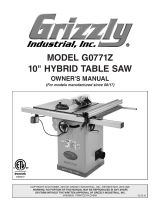Page is loading ...

COPYRIGHT © APRIL, 2019 BY GRIZZLY INDUSTRIAL, INC.
WARNING: NO PORTION OF THIS MANUAL MAY BE REPRODUCED IN ANY SHAPE
OR FORM WITHOUT THE WRITTEN APPROVAL OF GRIZZLY INDUSTRIAL, INC.
FOR MODELS MANUFACTURED SINCE 04/19 #JL20374 PRINTED IN USA
MODEL H4231
ZERO-CLEARANCE
TABLE INSERT FOR
G1023RL Series
INSTRUCTIONS
Important Considerations
CARBIDE BLADES: Only recommended for use
with carbide tipped blades.
DEDICATED INSERTS: Use a separate insert for
each blade, dado stack, or angle set-up. This
will ensure a true “zero-clearance” effect and
give you maximum benefit from your table
inserts.
SPLITTER/RIVING KNIFE: If this insert is to
be used with a splitter or riving knife, you
will need to finish cutting out the pre-routed
optional splitter slot, using a saw or router.
Smooth any leftover sharp edges with sand-
paper.
DADO BLADE: Use extreme caution when cut-
ting the blade slot (kerf) by moving the blade
much slower than otherwise due to the sub-
stantial cutting forces from the wide dado
blade.
Installing and Fitting Your Insert
1. Lower the blade completely.
2. Make sure the rear adjustment screw (Figure
1) is threaded in completely.
• Disconnect saw from power before fitting
or removing table insert!
• Always wear eye protection.
• Do not tilt the blade while it is in the insert!
For beveled cuts, a separate insert must
be used with the blade slot (kerf) cut only
at that angle.
• Insert must be securely clamped down
with a board before plunging the blade
up through it to cut the kerf.
• If using a blade stabilizer, check the
clearance before raising the blade.
3. Put the insert in the throat opening (rear end
first so the anti-lift lug fits under the edge of
the table). The insert should fit in the table
opening with a snug fit.
—If the insert fits loosely in the opening,
remove it, and adjust the rear adjustment
screw as necessary until it fits correctly.
—If the insert will not fit in the opening, you
may need to lightly sand the "fitting bumps"
along the perimeter until it fits correctly.
4. Adjust the four leveling screws until the insert
is flush with the tabletop. Make sure that all
four leveling screws make contact with the
table so the insert does not wobble
Figure 1. Anti-lift lug and rear adjustment screw.
Anti-Lift Lug
Rear
Adjustment Screw

-2-
Model H4231 (Mfg Since 04/19)
Cutting the Blade Slot (Kerf)
1. Check that the insert is fitted properly and
that the blade is NOT touching the insert. To
check the blade clearance, you can rotate the
blade from below using a stick or by moving
the belt.
2. Place a scrap board over the top of the table
insert and firmly clamp the board to the table
at both ends, so the table insert will not lift
when you raise the blade into it during the
next step.
3. Re-connect the saw to power. KEEP HANDS
OFF OF THE TABLE TOP, DON'T STAND
DIRECTLY BEHIND THE BLADE PATH,
AND WEAR EYE PROTECTION. Switch the
saw on, then slowly and cautiously raise the
blade up to its maximum height to cut through
the insert.
4. Lower the blade completely, turn the saw off,
then remove the clamping board. The insert
is now ready for use!
Note: Under certain conditions, an undesir-
able scraping noise may be generated by
excessive arbor run-out or blade distortion,
causing the blade body to intermittently con-
tact the insert slot. To remedy this, remove
the insert and slightly widen the slot, using a
file or sanding paddle.
If you need help with your new insert, call our
Tech Support at: (570) 546-9663.
/




